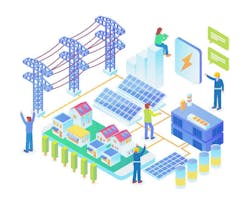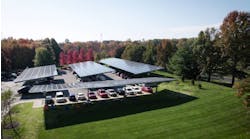With interest growing in how microgrids can benefit the cable industry, the Society of Cable Telecommunications Engineers (SCTE) is looking into operational practices and standards that can boost industry awareness and enhance information exchange, investment and deployment.
By naulicreative/Shutterstock.com
SCTE and its international arm, the International Society of Broadband Experts (ISBE), recently launched a microgrid working group to demonstrate that microgrid technology is economically feasible, can improve energy and operational resilience and reduce operating costs for cable services providers. The working group comes under the umbrella of SCTE-ISBE’s ANSI-accredited Standards Program and will be carried out within its Energy Management Subcommittee in conjunction with the industry association’s Energy 2020 program.
“While much of the industry’s focus in recent years has been on reducing power costs and consumption, sustainability and the ability to maintain operations in the face of grid power interruptions are topics that are key to operators’ businesses,” said David Martinson, vice president of EMerge Alliance and chair of the microgrid working group. “Microgrids can contribute new solutions in three key areas that have been raised during the Energy 2020 meetings — energy cost, energy availability, and the seamless ability to incorporate renewable technologies into the power portfolio.”
Charting a pathway for cable industry microgrid projects
SCTE-ISBE has been carrying out on-site, clean energy generation and distribution projects at its headquarters in Exton, Pennsylvania in recent years. “As we’ve shown with our own projects at SCTE-ISBE headquarters, photovoltaic systems, fuel cells, storage batteries, and other sources can maintain essential powering when the utility grid is unavailable,” said Derek DiGiacomo, senior director, energy programs and business continuity. “The expertise of the Microgrid Working Group will jump-start the ability of the Energy Management Subcommittee to provide the industry with standards and operational practices related to hardened availability and ‘renewability’ of power supplies.”
SCTE-ISBE sees a lot in the way of diesel power generators being used to provide emergency, back-up power among its membership. Furthermore, cable operators typically have DC power plants in the batteries and uninterruptible power supply (UPS) systems. That makes DC microgrids one, but not the exclusive, option for the industry, DiGiacomo pointed out in an interview. This helps explain EMerge Alliance’s partnership in SCTE-ISBE’s new Microgrid Working Group. EMerge Alliance is developing and promoting standards development for DC power distribution in commerce and industry.
A small, cable services facility’s power capacity could be as little as 5 kW. The power capacity of large Class B or C facilities that serve as head-end sites can be as much as half a megawatt, according to SCTE-ISBE spokesperson Paul Schneider.
SCTE-ISBE deployed an 11.28-kW-ac solar photovoltaic system at its headquarters in 2010. Since then it’s been increased to 23 kW-ac. Eight kilowatts is grid-interactive, meaning the system can charge its batteries and provide critical power to essential services in the event the grid goes down, Schneider said. The remaining 15 kW is grid-tied, dispatching electricity to the utility grid.
The costs, benefits, risks and rewards of investing in distributed energy and microgrids will depend, in part, on the scale of the systems deployed, according to DiGiacomo.
“We have seen since the start of the 2020 program the costs of renewable deployment, especially solar, becoming more attractive. From our own experience here at SCTE-ISBE’s headquarters, we have found little risk in the solar plant and batteries we have installed. There are no moving parts and very little maintenance is required based on our Pennsylvania location,” he said.
However, the return on investment for microgrids owned by cable services providers may not be as high as that for other consumer-facing technology projects, according to DiGiacomo. But the rewards — use of green energy, lower overall carbon emissions and enhanced resilience — are there to be had when solar generation is paired with battery energy storage, he added.
Triple win
DiGiacomo sees encouraging signs for the future of microgrids in the cable industry. Some providers may already be running a microgrid in their facilities but don’t label the infrastructure as such, he pointed out.
“We are fortunate in the U.S. and North America to have a power infrastructure that is dependable; however, we also realize that as broadband-based services continue to increase in customer criticality, taking advantages of multiple sources of power makes a lot of sense. It helps break down that single point of failure. And when combined with renewables, this can be done in a sustainable manner,” DiGiacomo said.
In addition, microgrids afford cable services operators a way to participate in utility demand-response programs via peak-shaving. That can reduce energy costs.
“For example, facility-cooling peak needs can be offset by leveraging solar PV as the hottest days will often correlate to the sunniest days, thus providing opportunity for solar support,” he said.
Cable industry participants should take a strategic approach towards incorporating renewable energy and microgrids in their operations, according to DiGiacomo.
“The goal of triple-win — good for power reliability, good in terms of cost savings and ultimately good for our customers — should help drive the decisions on when, where and what kind of renewable energy or microgrid should be leveraged,” he said. “I believe we have already begun the adoption of this technology and our Energy 2020 Program has helped with that momentum as an industry advocate for sustainable technical power solutions.”
Track news about cable industry microgrid projects. Subscribe to the free Microgrid Knowledge newsletter.







